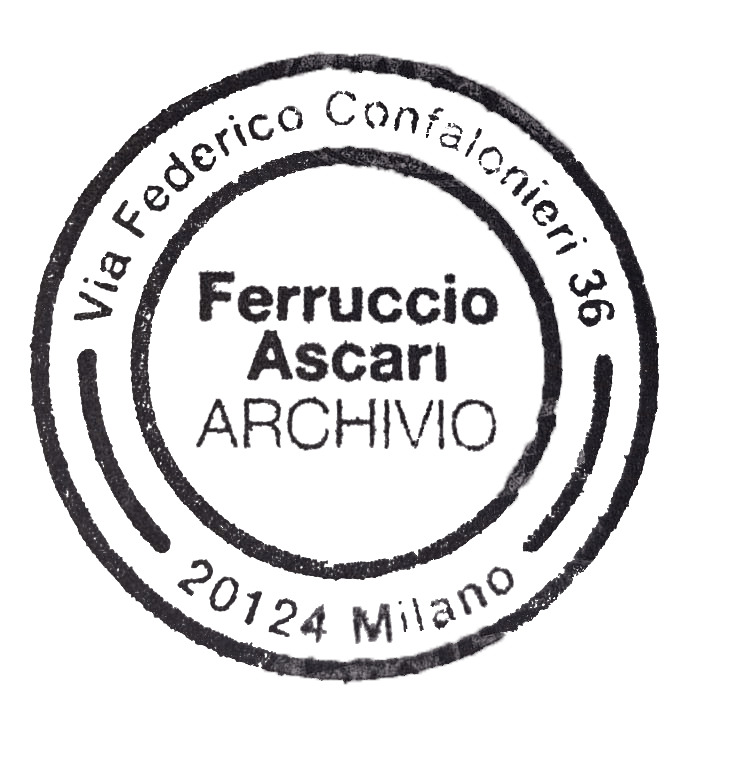20
17
Silenzio
Amen
Logos
Silenzio, Amen and Logos are the three works placed in the central nave of the rectory church of San Raffaele, in Milan, in the context of the personal exhibit “Silenzio” (1) of Ferruccio Ascari articulated simultaneously in other locations in town, which are extraordinary in terms of historical and artistic value : the small cloister of the Basilica of San Simpliciano, where the installation Luogo Presunto, was located, and San Bernardino alle Ossa, with Ex Voto I, II, III e Rumore.
[read] Silenzio (Silence) – a large linen sheet hung at the start of the nave, bearing this word embroidered in gold in its center – was the first work that you encountered when entering the church of San Raffaele. Speaking of this work, Ferruccio Ascari stated: “More than the title of the work, Silenzio is the work. The title and the work are one. Silence says what it means, but not in a tautological way. My intention was to amplify the warning, making it resound inside the spectator, as I mentioned earlier. I liked the idea of the writing being small and at the center of a large neutral field where it could reverberate…”.
On high, suspended above the steps leading up to the altar, was collocated the work Amen, a tryptic whose entire surface was covered by the word “amen” in its original language, that is Hebrew. This decision to work with the word, with the written word rather than the image, alludes to the “unrepresentable” nature of the divine. The technique of the fresco mounted on canvas that characterizes Ascari’s painted is combined with a golden background: a clear throwback to Italian art of the thirteenth century, but also to Byzantine icons and their theological as well as artistic significance. As we will see in Mantra, the artist’s formal choices are in themselves a declaration of intent: the drastic reduction of figural elements, the golden background, transform this work into an object of meditation, in a contemporaneous way, with an implicit reference to – by way of Malevich’s Black Square – the icon, to its theological meaning other than artistic, to its being a “presence” and not only a simple representation.
/
Logos, a wooden egg covered with golden leaves, has been placed by the artist inside the ciborium, above the altar, in the holiest of places in the church. This work represented the final point of a vanishing point that started with Silenzio and continued with Amen: an ascensional path not only in visual terms, but also in a more intimate sense of whom these works represent the stages. With regard to this work, the artist stated: “I usually start to think of a title when I’ve finished a work, but in this case the word came first, and it’s a word that comes from a memory: ‘In the beginning was the Word (Logos), and the Word was with God, and the Word was God…’ (John,1:1-5). John continues: ‘All things were made through him, and without him was not anything made that was made. In Him was life, and the life was the light of men…’. The idea of the golden egg came to me first and foremost from those words. I thought of the egg as a symbol of the most important Christian holy occasion, the Resurrection. But not only in those terms. The egg came to me, of course, as a ‘rebirth’, but before that, I thought of it as a ‘birth’, the birth of everything, as a cosmogonic egg”.
/
(1) With regard to this exhibition, in an interview given in that occasion Ferruccio Ascari declared: “The relationship between the work and the space in which it is placed has always been a central element of my work, and this since the first environmental installations that I realized from the mid ’70s onwards: in many of these works the location represents a fundamental aspect of the work. All the more in this case. Here we are not dealing with simple exhibition spaces, but with places that for me represent the occasion for a special interior path other than esthetical. For the visitor this path should transform in an experience… The title (of the exhibition, editor’s note), Silence, implies a particular condition, a ‘being ready to listen’. Without silence, things cannot speak to our hearts; they cannot reveal their hidden significance. I began systematically practicing silence in India where I went to study for several years. The practice is known as ‘mauna’ in India, and it is an important element in self-awareness paths. And silence is a practice found in all great traditions…”.
[/read]
Silenzio. Linen sheet and gold, approx. 140×140 cm, 2017 [Church of San Raffaele, Milano]
Amen. Fresco transferred to canvas, 90×40 cm, 2017 [Church of San Raffaele, Milano]
Logos. Wooden egg covered with golden leaves, approx. 10x10x20 cm, 2017 [Church of San Raffaele, Milano]












 [vc_video link=”https://vimeo.com/220934514″ align=”center” src=”“https://player.vimeo.com/video/220934514“” width=”“640“” height=”“360“” frameborder=”“0“”]
[vc_video link=”https://vimeo.com/220934514″ align=”center” src=”“https://player.vimeo.com/video/220934514“” width=”“640“” height=”“360“” frameborder=”“0“”]


 [vc_video link=”https://vimeo.com/220934514″ align=”center”]
[vc_video link=”https://vimeo.com/220934514″ align=”center”]















































 [vc_raw_html]JTNDaWZyYW1lJTIwd2lkdGglM0QlMjIxMDAlMjUlMjIlMjBoZWlnaHQlM0QlMjI0NTAlMjIlMjBzY3JvbGxpbmclM0QlMjJubyUyMiUyMGZyYW1lYm9yZGVyJTNEJTIybm8lMjIlMjBzcmMlM0QlMjJodHRwcyUzQSUyRiUyRncuc291bmRjbG91ZC5jb20lMkZwbGF5ZXIlMkYlM0Z1cmwlM0RodHRwcyUyNTNBJTJGJTJGYXBpLnNvdW5kY2xvdWQuY29tJTJGdHJhY2tzJTJGMTg5Mjg3NDM2JTI2YW1wJTNCYXV0b19wbGF5JTNEZmFsc2UlMjZhbXAlM0JoaWRlX3JlbGF0ZWQlM0RmYWxzZSUyNmFtcCUzQnNob3dfY29tbWVudHMlM0R0cnVlJTI2YW1wJTNCc2hvd191c2VyJTNEdHJ1ZSUyNmFtcCUzQnNob3dfcmVwb3N0cyUzRGZhbHNlJTI2YW1wJTNCdmlzdWFsJTNEdHJ1ZSUyMiUzRSUzQyUyRmlmcmFtZSUzRQ==[/vc_raw_html]
[vc_raw_html]JTNDaWZyYW1lJTIwd2lkdGglM0QlMjIxMDAlMjUlMjIlMjBoZWlnaHQlM0QlMjI0NTAlMjIlMjBzY3JvbGxpbmclM0QlMjJubyUyMiUyMGZyYW1lYm9yZGVyJTNEJTIybm8lMjIlMjBzcmMlM0QlMjJodHRwcyUzQSUyRiUyRncuc291bmRjbG91ZC5jb20lMkZwbGF5ZXIlMkYlM0Z1cmwlM0RodHRwcyUyNTNBJTJGJTJGYXBpLnNvdW5kY2xvdWQuY29tJTJGdHJhY2tzJTJGMTg5Mjg3NDM2JTI2YW1wJTNCYXV0b19wbGF5JTNEZmFsc2UlMjZhbXAlM0JoaWRlX3JlbGF0ZWQlM0RmYWxzZSUyNmFtcCUzQnNob3dfY29tbWVudHMlM0R0cnVlJTI2YW1wJTNCc2hvd191c2VyJTNEdHJ1ZSUyNmFtcCUzQnNob3dfcmVwb3N0cyUzRGZhbHNlJTI2YW1wJTNCdmlzdWFsJTNEdHJ1ZSUyMiUzRSUzQyUyRmlmcmFtZSUzRQ==[/vc_raw_html]










































